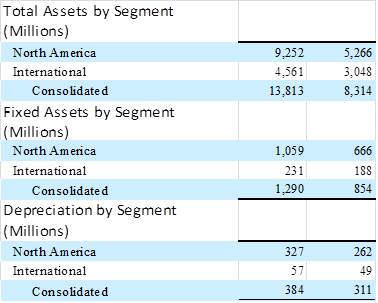8.22 Segment Reporting
US GAAP,
under statement FASB Statement 131 requires that a firm defines a
segment for reporting purposes, in the same way.
That is, the definition of an operating segment for external
reporting standards is the same as the organization’s actual
internal organizational structure.
As a result, the definition of a segment is relevant to
understanding the drivers of aggregate operating income and cash
flows if we break performance down to primitive segments.
Segment reporting under International
Accounting Standards was revised with the recent release of IFRS 8,
to bring it in line with US GAAP.
This standard supersedes IAS 14 and shifts attention away
from geographical definitions to alignment with management’s
decision making. Of
course, both sets of standards still permit geographical definitions
but only if the organization is organized this way.
For example, consider the case of Amazon.Com.
Example: Amazon.Com
In Item 8,
Part 2 of their 2010 10-K, Amazon describe their segment reporting.
You should note that although they define their segments
relative to geographic lines it is consistent with US GAAP because
of the link to the chief executive’s review:
We present our segment information along
the same lines that our chief executive reviews our operating
results in assessing performance and allocating resources.
The full text is provided below:
AMAZON.COM,
INC.
NOTES TO
CONSOLIDATED FINANCIAL STATEMENTS—(Continued)
Note 11—SEGMENT
INFORMATION
We have
organized our operations into two principal segments: North
America and International. We present our segment information
along the same lines that our chief executive reviews our
operating results in assessing performance and allocating
resources.
We allocate to
segment results the operating expenses “Fulfillment,”
“Marketing,” “Technology and content,” and “General and
administrative,” but exclude from our allocations the portions
of these expense lines attributable to stock-based compensation.
We do not allocate the line item “Other operating expense
(income), net” to our segment operating results. A significant
majority of our costs for “Technology and content” are incurred
in the United States and most of these costs are allocated to
our North America segment. There are no internal revenue
transactions between our reporting segments.
North America
The North
America segment consists of amounts earned from retail sales of
consumer products (including from sellers) and subscriptions
through North America-focused websites such as
www.amazon.com
and www.amazon.ca.
This segment includes export sales from
www.amazon.com
and www.amazon.ca.
International
The
International segment consists of amounts earned from retail
sales of consumer products (including from sellers) and
subscriptions through internationally focused websites such as
www.amazon.co.uk,
www.amazon.de,
www.amazon.co.jp,
www.amazon.fr,
and www.amazon.cn.
This segment includes export sales from these internationally
based sites (including export sales from these sites to
customers in the U.S. and Canada), but excludes export sales
from www.amazon.com
and www.amazon.ca.
Amazon reports the
financials as follows:

And the
Consolidated Results are:

You can
compute NOPAT (Net Operating Profit After Tax)
per segment:
Operating Profit times (1 – Tax Rate) per segment by assuming that
the tax rate is 253/902 or 28% for Amazon in 2009.
Segment
NOPAT North America
is: 709*(1-0.28) = 510.13
Segment
NOPAT International
is: 863*(1-0.28) =
620.94
In
addition, Amazon provided the following Balance Sheet Information by
segment:

